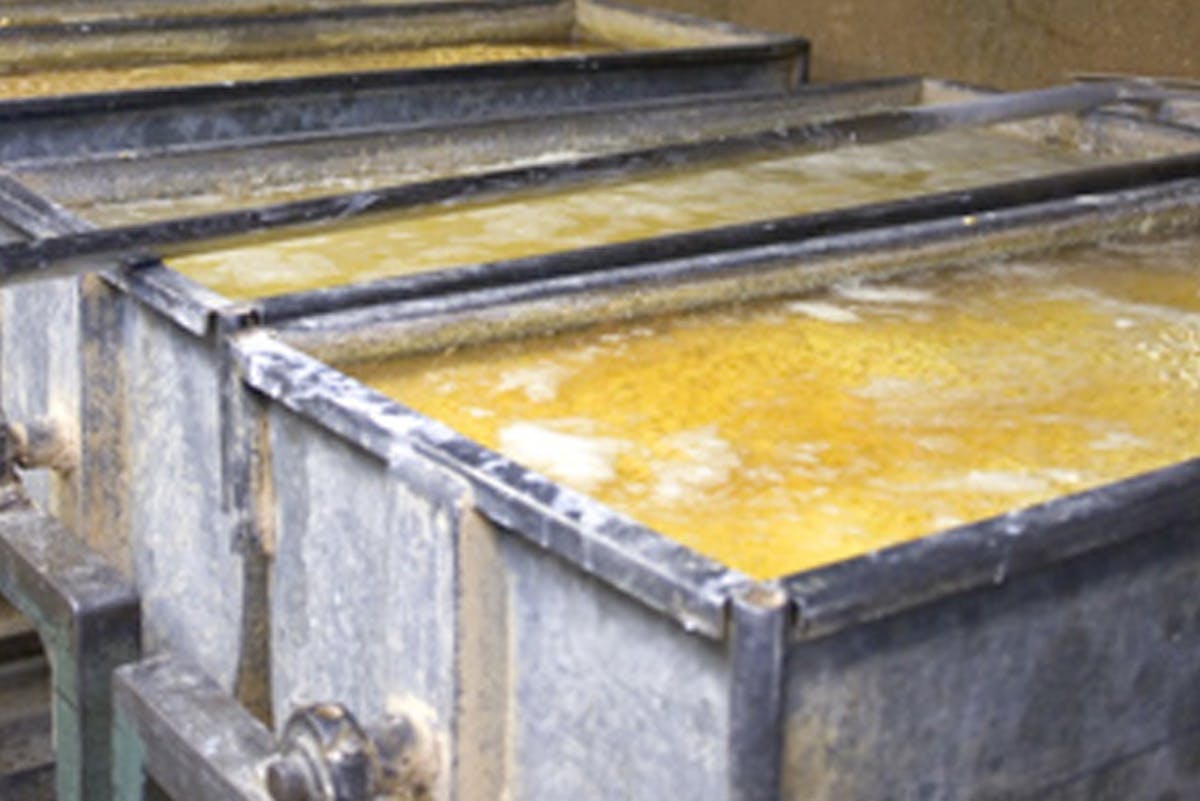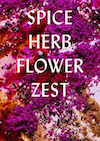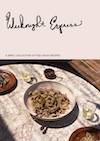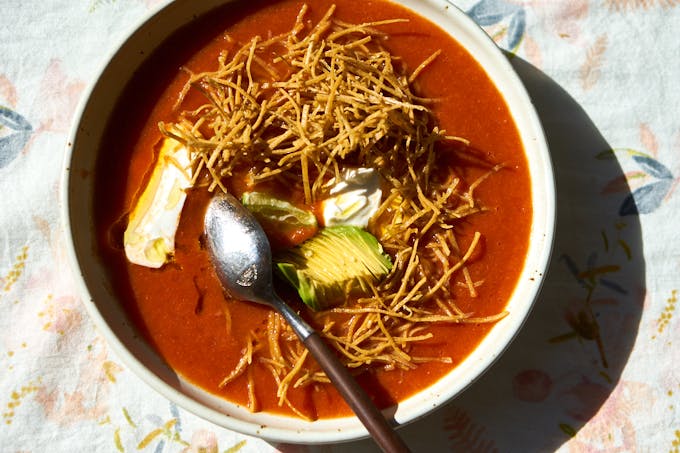Handmade Corn Tortillas Recipe
Making Corn Tortillas as instructed by Diana Kennedy: From My Mexican Kitchen.

Dallas. After six days, three Texas BBQs, a culinary highlight tour of the Dallas metropolitan area, a cookbook signing, a handful of informative IACP panels, conversations sparked by finally being able to put names with faces, and one cancelled flight - I am home from a city that may be the worst place on earth to be a vegetarian. It might not have be so bad if you had access to a kitchen - much of the produce I saw in the Dallas Central Market looked diverse and beautiful, but having a non-meat entree on a menu seems to be a foreign concept in the Big D. I knew within the first twenty-four hours that there were going to be a lot of meals consisting of chips, salsa, and cheese quesadillas ahead of me.

Luna's Tortilla Factory: Keeping watch over the cooking corn kernels
Outside of conceding to a week of side salads and random appetizers, I very much enjoyed my time spent in Dallas and at the conference. I feel like I made some new friends that I will stay in touch with for a long time. Another highlight for me was visiting a handful of local establishments, new and old, run by individuals or families who all had two things in common - passion and dedication. It sounds a little hoaky, I know - but it is true, and I don't know how else to describe it. These were some hard working, independent entrepreneurs putting in serious hours of sweat equity. We were invited to tour each facility, ask questions, poke around, and sample their delicious creations.
The list of the places we visited:
-Luna's Tortilla Factory
-Frutitas Paleteria
-Fiesta Market
-Paula Lambert's Mozzarella Company
-Lunch at Pepe & Mito
-Rudolph's Meat Market
-Paciugo Gelato
-La Duni

Frutitas Paleteria: A sea of fresh fruit popsicles.
Today's flavor: strawberry.
I brought back a small handful of wonderful recipes from Dallas including a decadent quatro leche cake kissed with burnt sugar meringue frosting that I can't wait to try in my own kitchen. For today's write-up I am going to focus on the Luna's Tortilla Factory, an 80-year old establishment in the historic Little Mexico part of Dallas founded by Maria Luna - still operated by her immediate family. If you've never tasted a warm, fresh, corn tortilla - you are missing out on a great pleasure. The corn tortillas you typically find in supermarkets are produced to be able to withstand something like 21 days on the shelf. The difference between a corn tortilla made right before your eyes and one that has been on the shelf for two weeks....well, it is a shame to call them by the same name.

Beautiful vintage walls in the restaurant next door to Paula Lambert's Mozzarella Company
Luna Tortilla was our first stop of the day. We filed into the front of the 1930's-era store decorated with paintings of vibrant Mexican women and shelves of tiny to medium-sized artisan crafts sprinkled about. The walls were made of stunning, vibrant, solid turquiose mosaic tiles that had the patina and irregularity that goes hand in hand with age. The place is family-run, and still in its original location.
Corn tortillas are made with three ingredients; dried corn, water, and lime (not the lime you squeeze, a food-grade quality of the powdered lime (calcium oxide) you see out on a baseball diamond). At Luna's the corn, water, and lime is heated in large non-reactive vats (you can see it cooking in the lead picture). You know the corn is done cooking when the papery skin on the outside of the corn kernels slides off when rubbed between your fingers - the corn is removed from the heat and allowed to soak. After soaking, the kernels are rinsed in a step that removes all the softened skins, they are almost completely white at this point except for the little yellow pedical at the top of the kernel which stays yellow. The corn is drained and milled to a soft, smooth texture, and the resulting dough (masa) is ready to be used for tortillas, tamales, etc. Here in San Francisco you can buy fresh masa from many of the Mexican grocers, but if you are ambitious and interested in making and grinding your own masa at home, there are detailed instructions in Diana Kennedy's book. At Luna's, the masa is then pressed into thin rounds, cooked, and voila! - fresh tortillas.
When you are using fresh masa at home, it should be used right away - the same day if at all possible. The flavor will shift over time and you will loose the wonderful flavor of the corn as the masa begins to sour a bit. I am going to include Diana Kennedy's detailed recipe for making corn tortillas below - you will need a tortilla press (I got one a few years back, cheap) and you cook them on an ungreased comal or griddle. I love this Diana Kennedy book in part because it is wonderfully illustrated, through pictures, to show the reader exactly what the (sometimes unfamiliar) ingredients and equipment look like. The pictures give me that little extra boost of confidence I need when I am cooking recipes, trying new techniques, or shopping for ingredients that are outside what I already know...
Time to unpack. Let me know if any of you have made masa from scratch at home, and what your experience has been.
Making Corn Tortillas as instructed by Diana Kennedy
In her book this recipe is illustrated with step-by-step pictures.
1 1/2 pounds (675g) Tortilla Masa, about 2 1/2 cups
Water if needed
Work the masa with your hands to make sure the moisture is evenly distributed and there are no lumps or whole kernels that have escaped the grinding stones.
Here's a warning to save you a lot of tears about the first impossible tortillas: if the masa is too damp, then you will never be able to get it off the plastic bags (in the press). If this happens, flatten the masa and leave in an airy place to dry until manageable. If your masa is too dry, then it will crack and crumble as you attempt to make tortillas. Add some water, working it in well a little at a time. (I know from experience that a little water goes a long way and you can easily make it too wet.)
Either divide the masa into the number of tortillas you are going to make - but cover them with a damp cloth so they do not dry out while you are working with the first balls - or with more practice, just take off the lumps of the dough as you go along and keep the bulk of it covered while you work if the air is very warm and dry. Try to keep the balls as near the same size as possible. Mexican cooks are expert at this.
Heat the ungreased comal or griddle over medium heat. To test, the dough should sizzle slightly as it hits the hot surface. Line your tortilla press with two plastic bags. Place a ball of the dough on the bottom plate of the press and flatten it a bit with your hand. Close the top plate of the press down firmly - but don't put all of your weight on it - and flatten the tortilla very thin. Open the press up, and remove the top bag.
Lift up the bottom bag with the dough, and resting the dough on the inside of your fingers (do not rest the dough on your palm because it will be difficult to transfer onto the comal), carefully peel back the plastic bag. Take care to lay the tortilla on the comal and let it cook until the underside is just turning opaque and speckled with brown. Do not leave the tortilla to cook too much on the first side or it will be overcooked and inflexible.
Flip the tortilla over and cook a little longer on the second side. Flip it back again and continue for a few seconds more until the dough is cooked through and the top skin (ideally) puffs up. This will be the "face" of the tortilla, and since it is likely to flake off, it will always go inside when making a taco or enchilada. (Note: Any traditional Mexican cook will tell you that a tortilla should never be turned more than twice.)
Unless you are going to eat it right away, place the freshly made tortilla immediately on top of the rest wrapped in a thick cloth, or a cloth-lined basket, to keep them warm and flexible. This process does need some practice until you become adept at recognizing what the masa should ideally feel like, just the right heat under the comal, and the timing of the turns. When you have those mastered, it is a soothing, therapeutic sort of job after a possible frenzied first attempt.
Wipe off the plastic bags and reserve them for a lot of other tortilla making. Make sure the inside plates of the tortilla press are clean and place a double layer of paper toweling between them when storing the press. Wipe the comal off with a slightly greased paper and store.
Note: Tortillas can be made with Maseca, Minsa, or masa harina, but only use these dried corn products as a last resort. They do not have the same flavor or the texture of the real thing, and the tend to discintegrate when used for chilaquiles, tortilla soup, or casseroles.
Makes 15 5 1/2-inch tortillas.
From My Mexican Kitchen: Techniques and Ingredients by Diana Kennedy (Clarkson Potter, 2003) - reprinted with permission




Comments are closed.
Apologies, comments are closed.
Comments
One way around the problem of finding chicos and lime, slaking it yourself and then milling it yourself to get delicious corn tortillas is to use the maseca but add some ground hominy to it. The hominy adds a bit of flavor to the maseca. Even just straight maseca tortillas are better than store bought corn tortillas, and are a cinch to make.
I lived in the Southwest for years, so I am a big fan of this regional cuisine. I’ll be excitied to see how this trip influences your future recipes on this site, especially since you are a vegetarian, and as you mention, it’s not easy being veggie in Texas!
Enjoyed reading Diana Kennedy’s tortilla making instructions! I live in Guatemala now and the tortillas here are hand patted out rather than pressed. This results in a gummy tortilla…I am inspired now to buy a tortilla press and teach my Guatemalan housekeeper how to use it!!
I LOVE mexican food! I have Diana Kennedy’s cookbook, as well as two of Rick Bayless’. Huz and I have made our own masa (by using harina flour), but prefer it fresh from the local mexican market. I’m hungry. Great blog!
Heidi
these photos are amazing.
I didn’t think your photography could get any better, then you turn out these.
marvellous stuff!
Re: the ginger cookie question – I would make them into mini ice cream sandwiches – with honey ice cream, or lemon sherbert, etc in the middles. -h
Hi,
I know this has nothing to do with tortillas, but I have a quick recipe question that seems like a perfect fit for your great site. I have just fallen in love with chewy, gingerbread cookies from Trader Joes. They have crystalized ginger in them and are great. I was wondering if you have any ideas on how to make these into a great dessert – maybe a twist on tiramisu or something.
I have a friend who is getting married soon, and her wedding shower includes everyone bringing a recipe. I think she would love these cookies, but I was hoping to give her a fun dessert recipe that is a bit special.
(Just a side note, I’m not affiliated in any way with the maker of the cookies. Also, I’m not a great cook, but do love desserts and love your site. Your photos are fantastic and always make me hungry!)
Thanks for your help!
as far as i can tell, it’s actually quite difficult to find real fresh masa in the bay area. most of the mexican grocery stores in the mission that sell “masa para tamales,” are in reality just selling maseca dough.
i’ve only found two places to get real fresh masa in the bay area. one is a stall out behind the ferry building farmers’ market that sells mexican food. they also sell fresh, organic, stoneground corn masa — if you get there early enough, before it’s sold out. there’s also a great latino market in fruitvale, but embarrassingly enough i can’t remember what it’s called right now…
has anyone found other places to get high quality, fresh masa that’s not made from maseca? i’d love to find somewhere closer to my apartment…
Heidi,
I wish I’d had time to read about your trip to Dallas before you left. I was in charge of lunch at my school’s dining room last Thursday, so I was sort of off-line all week.
The next time you’re here, you have to visit Cafe Brazil. They have quite a few vegetarian entrees. There’s also Cosmic Cafe 2 or 3 blocks away. It’s all vegetarian, and most dishes are vegan.
I do a fair amount of vegetarian cooking at church and on catering jobs, so I’m constantly eating out to get new ideas.
I’m glad you enjoyed your trip to Dallas. Come back soon.
As a vegetarian I can relate! I attended a coffee conference in Dallas during the late 80’s and thought I would starve to death! Even salads were hard to come by. I was very thankful to get back to L.A.
Fresh masa is best. If you are going to freeze it, you can probably get away with it for a few weeks or up to a month. After that it gets sort of crumbly and breaks when you go to flaten it out to shape the tortillas. -h
Shwew, I’m glad i’m off the hook for trying to tackle making masa at home, I’ll just buy the fresh masa and use the press. Did you say that masa could be frozen successfully?
Heidi: I, too, was at IACP last week and am sorry I didn’t get to meet you. I lived in Dallas for about 7 years, and have lived in Fort Worth since. In our defense, I’d like to say that the lack of vegetarian offerings is more a function of being part of a pre-planned conference than the actual availability of vegetarian/vegan cuisine. Granted, meat-eaters are still the majority but I’ve seen a huge change in the restaurant scene since I first moved to Texas in 1992. That said, I’m glad you had some nice experiences while you were here, and do come back any time now, ya hear?
You know, I actually had the spinach enchilada for lunch at Pepe & Mito – and it was quite tasty. I loved the space Pepe & Mito’s was in – alot of color and character. I didn’t look at their full menu – we had a pre-set lunch created for our group.
The owner was really nice – I think it is challenging when you get a big wave of people in there, we had (50-ish people)…the food looked very appetizing in general but all the antojito platters served that day looked like they were 100% non-vegetarian.
Anyways, I think the market drives and defines what people are offering on the menus. Maybe there isn’t a big vegetarian population in Dallas. I don’t remember it being nearly as big a deal in say, Austin – with its big student population, and college town vibe.
To be fair I also didn’t do a ton of research ahead of time – knowing I would be at the mercy of a pre-set curriculum for the majority of my visit. -h
I couldn’t help but laugh at your description of Dallas – my whole family is from Dallas, and, when I was a vegetarian, I would have to beg to have something made for me. Even salads have meat on them in some form or another! Greens are cooked with bacon or ham – it’s a nightmare. Congratulations on survival, Heidi!
Hi- boy, I wish I had posted this before your trip to Dallas, but for future reference and for anyone else traveling to that area…there is a wonderful vegan restaurant called Spiral Diner in Fort Worth. Be sure to check it out (if you ever find yourself down there again). http://www.spiraldiner.com/
What about the spinach quesadillas or spinach enchiladas at Pepe & Mito (though there may be non-veg stuff in them)? That’s my first stop when I go back to visit the family.
Comments are closed.
Apologies, comments are closed.
More Recipes
Weekly recipes and inspirations.
Popular Ingredients